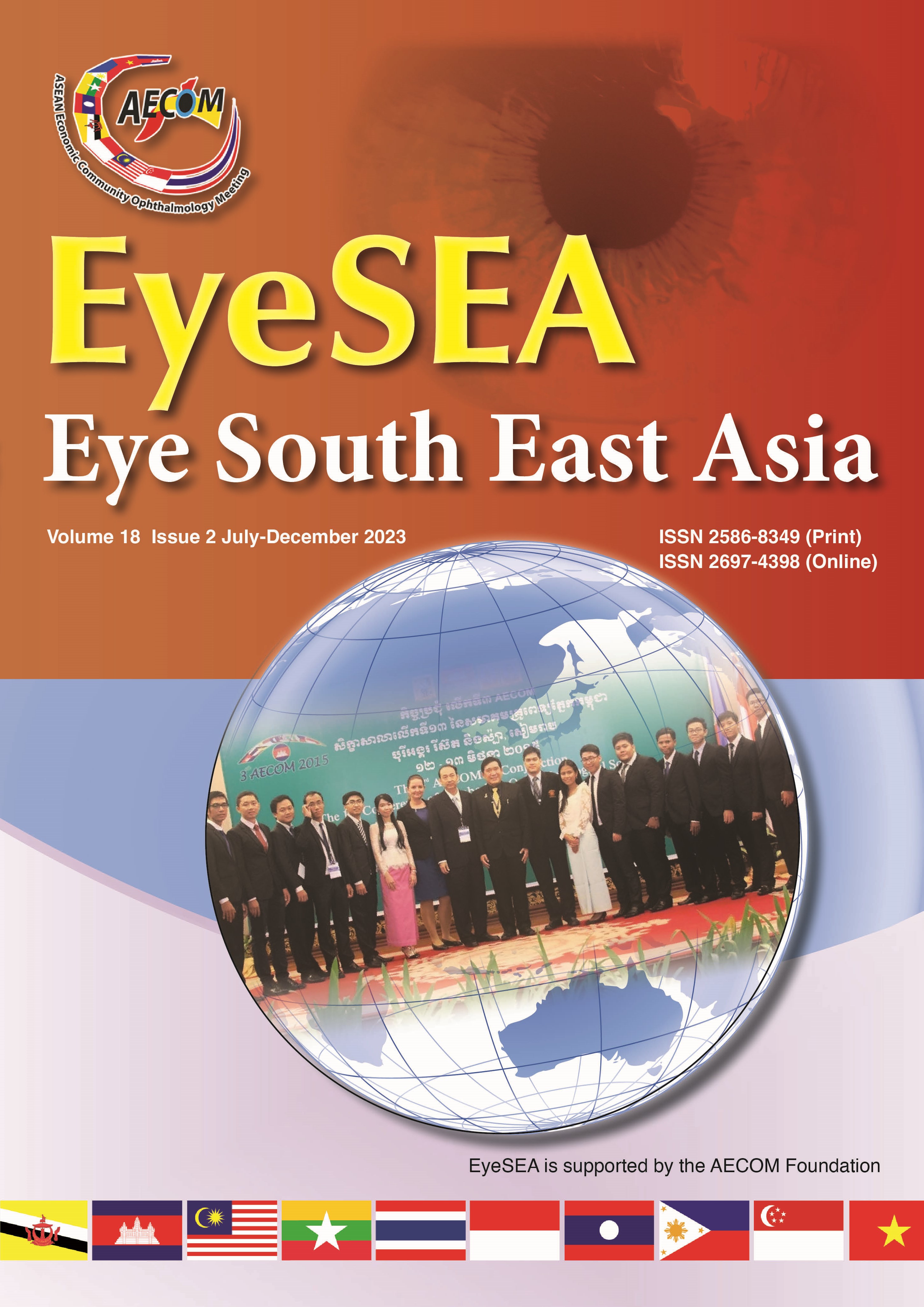The comparison of pain perception between polypropylene and chromic catgut suture in Müller muscle’s conjunctival resection with externalization of suture knots; a randomized controlled trial
Main Article Content
Abstract
Objective: Muller’s muscle conjunctival resection (MMCR) is a posterior approach surgical technique to correct blepharoptosis. The purpose of this study was to compare the patient-reported pain scores and surgical outcomes between polypropylene sutures and chromic catgut sutures.
Methods: A prospective randomized comparative clinical trial enrolled subjects from one tertiary eye center. Patients undergoing unilateral MMCR were randomized to receive either a polypropylene suture or a chromic catgut suture. Upper eyelid margin-to-reflex distance was measured and recorded before and after surgery. Then, pain scores were quantified using the pain visual analog scale: measured during surgery, one day after surgery, and when the sutures removed. The results were analyzed using an unpaired t-test.
Results: The study enrolled twenty-two unilateral cases. Seventeen (77%) of the subjects were female. The mean patient age was 45 years (45.18). The mean margin-to-reflex distance was 1.84 mm preoperatively, which increased to 2.96 and 3.09 mm one month postoperatively in the polypropylene and the catgut suture groups, respectively (P-value <0.0001). Results demonstrated significant pain scores difference between the two sutures during sutures removal. There were no suture-related complications.
Conclusion: Patients receiving polypropylene sutures reported significantly more pain during suture removal than those receiving catgut sutures. However, the surgical outcomes were not different.
Conflicts of interest: No conflict of interest is reported.
Article Details

This work is licensed under a Creative Commons Attribution-NonCommercial-NoDerivatives 4.0 International License.
References
Guidoin R, King MW, Gupta BS, King MW. Biotextiles as medical implants. Woodhead Publishing; 2013.
Putterman AM, Urist MJ. Muller muscle-conjunctiva resection. Technique for treatment of blepharoptosis. Arch Ophthalmol.1975;93:619-623
Choudhary MM, Chundury R, McNutt SA, Perry JD. Eyelid contour following conjunctival mullerectomy with or without tarsectomy blepharoptosis repair. Ophthal Plast Reconstr Surg.2016;32:361-365.
Saha K, Leatherbarrow B. Conjunctival sparing Muller's muscle resection for the management of blepharoptosis in the anophthalmic patient. Clin Experiment Ophthalmol. 2011;39:478-479
Gildener-Leapman JR, Sheps I, Stein R, Benyamini O, Milstein A, Hartstein ME. The Sutureless Mullerectomy. Ophthalmic Plast Reconstr Surg. 2019 May/Jun;35(3):290-293. doi: 10.1097/IOP.0000000000001331. PMID: 30844915.
Ediriwickrema LS, Geng J, Nair AA, Prendes M, Gerber AL, Yang PT, Liu CY, Nunery WR, Harold Lee HB, Kikkawa DO, Korn BS. Single Suture Müeller Muscle Conjunctival Resection (ssMMCR): A Modified Technique for Ptosis Repair. Ophthalmic Plast Reconstr Surg. 2019 Jul/Aug;35(4):403-406. doi: 10.1097/IOP.0000000000001380. PMID: 30908466
Patel RM, Chuang AZ, Sartori J, Aakalu VK, Putterman AM, Setabutr P. The significance of minimal adjustments in the Muller's muscle and conjunctiva resection procedure to achieve the phenylephrine result. Orbit. 2015 Apr;34(2):79-83. doi: 10.3109/01676830.2014.999287. Epub 2015 Mar 25. PMID: 25804407; PMCID: PMC5010361.
Gupta BS, Wolf KW, Postlethwait RW. Effect of suture material and construction on frictional properties of sutures. Surg Gynecol Obstet. 1985 Jul;161(1):12-6. PMID: 4012537.00
Lock AM, Gao R, Naot D, Coleman B, Cornish J, Musson DS. Induction of immune gene expression and inflammatory mediator release by commonly used surgical suture materials: An experimental in vitro study. Patient Safety in Surgery. 2017;11(1).
Bennett RG. Selection of wound closure materials. Journal of the American Academy of Dermatology. 1988;18(4):619–37.


